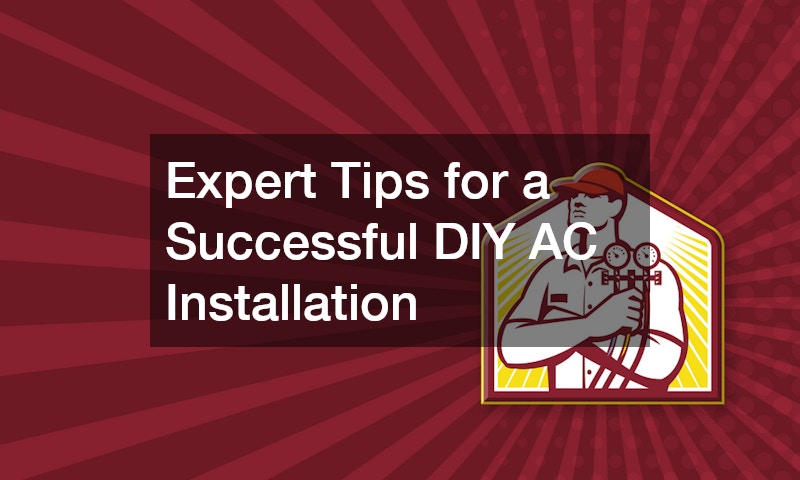Adding air conditioning to your home can feel like a daunting and expensive project, but with a bit of knowledge and the right approach, you can achieve a comfortable and cool living space without breaking the bank. Many homeowners believe that professional installation is the only option, but DIY AC installations can save you thousands of dollars while providing a rewarding sense of accomplishment.
Here’s a step-by-step guide to help you navigate the process, cut costs, and enjoy the benefits of a more comfortable home environment.
1. Assess Your Existing Setup
Before diving into an air conditioning installation, take a close look at your home’s existing heating and cooling system. For homes with a furnace and ductwork already in place, the process becomes significantly easier and more cost-effective.
Check if your furnace is compatible with an AC coil. In some cases, if the furnace or coil has been updated within the last few years, it may already be set up for air conditioning. This saves you time, effort, and money by eliminating the need to replace or modify significant components of the system.
If your home doesn’t have ductwork or a compatible furnace, don’t worry. While this adds some complexity, there are resources and guides available to help you install ductwork or opt for alternative solutions like ductless mini-split systems.
2. Choose the Right Equipment
Investing in the right air conditioning unit is crucial for efficiency and long-term savings. Start by determining the cooling needs of your home, typically measured in BTUs (British Thermal Units). Using an online BTU calculator or consulting a professional can help you size your system appropriately.
Selecting a high-efficiency model may cost more upfront but will save you money on energy bills over time. Look for units with ENERGY STAR ratings or high SEER (Seasonal Energy Efficiency Ratio) ratings to maximize savings.
3. Gather the Necessary Tools and Materials
Successful AC installations require a set of tools and materials to get the job done safely and effectively. These might include:
- A vacuum pump and gauge set for refrigerant management
- Electrical tools for wiring connections
- PVC pipes for drainage
- Insulated refrigerant lines
- Safety equipment, such as gloves and goggles
Having the right tools on hand will make the installation process smoother and help you avoid unnecessary delays.
4. Follow a Step-by-Step Installation Process
Once you’re prepared, it’s time to begin the installation. Here’s a general overview of the steps involved:
- Position the Condenser Unit: Place the outdoor unit on a stable, level surface, ensuring proper clearance for airflow.
- Install the Indoor Coil: Attach the coil to your furnace if it’s not already in place. This coil acts as the evaporator for your system.
- Run Refrigerant Lines: Connect the indoor and outdoor units with insulated refrigerant lines, ensuring no leaks.
- Set Up Electrical Connections: Wire the system to your home’s electrical panel and ensure proper grounding.
- Test the System: Once everything is connected, test the system to confirm it’s working efficiently.
While this process may seem complex, breaking it into smaller steps and consulting detailed guides can make it manageable for DIY enthusiasts.
5. Avoid Common Mistakes
DIY AC installations can save you a significant amount of money, but avoiding common mistakes is critical to ensure your system functions properly. Some key points to keep in mind include:
- Proper Sizing: An improperly sized unit can lead to inefficiency, higher energy bills, and reduced comfort.
- Leak Prevention: Take extra care to seal all connections to prevent refrigerant leaks, which can harm the environment and compromise system performance.
- Drainage: Ensure proper drainage to prevent water damage or mold growth near your furnace.
If you’re unsure about any part of the process, consulting a professional for advice or assistance is always a wise decision.
6. Enjoy the Savings
One of the most rewarding aspects of DIY air conditioning installations is the significant cost savings. By handling the installation yourself, you can cut labor costs and avoid unnecessary markups on equipment.
Homeowners who follow this approach often save thousands of dollars compared to hiring a professional HVAC contractor. In some cases, these savings can amount to $8,000 or more, depending on the scope of the project and local rates.
7. Explore Financing Options for Equipment
Even with the DIY approach, the cost of equipment can be a concern. Many suppliers offer financing options to spread out payments, making it more manageable to purchase high-quality, efficient units. Be sure to compare prices and negotiate where possible to secure the best deal.
8. Consider the Environmental Benefits
Modern air conditioning units are designed to be more energy-efficient than ever before, reducing your carbon footprint and lowering your utility bills. By choosing an efficient system and installing it correctly, you contribute to a greener planet while enjoying the comfort of a cooler home.
Final Thoughts
Affordable AC installations are well within reach for homeowners willing to put in the time and effort to learn the process. By leveraging your existing system, choosing the right equipment, and carefully following each step, you can achieve professional results without the professional price tag.
The satisfaction of completing a DIY project and the financial benefits make this approach an excellent option for those looking to enhance their living space. Whether you’re tackling a first-time installation or upgrading an older system, the key is preparation, patience, and a commitment to doing the job right.
So, take the plunge into DIY air conditioning installations and enjoy the rewards of a cooler, more comfortable home—and substantial savings in your wallet.
.




